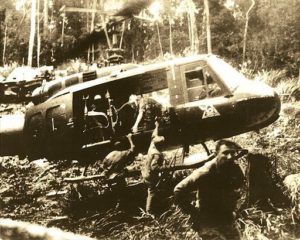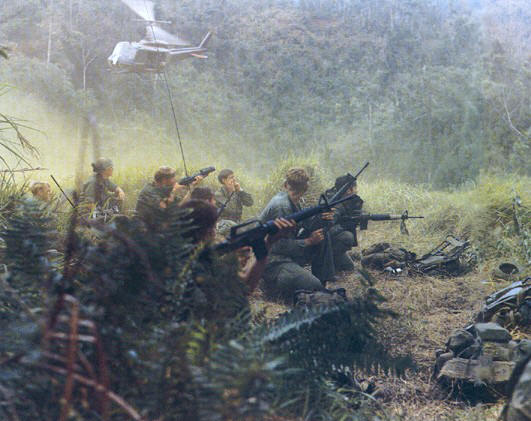 You’re a 19 year old kid. You are critically wounded and dying in the jungle somewhere in the Central Highlands of Viet Nam .
You’re a 19 year old kid. You are critically wounded and dying in the jungle somewhere in the Central Highlands of Viet Nam .
Its November 11, 1965. LZ X-ray, Vietnam.
Your infantry unit is outnumbered 8-1 and the enemy fire is so intense, from 100 or 200 yards away, that your own Infantry Commander has ordered the MediVac helicopters to stop coming in. You’re lying there, listening to the enemy machine guns and you know you’re not getting out. Your family is half-way around the world, 12,000 miles away, and you’ll never see them again.
As the world starts to fade in and out, you know this is the day. Then – over the machine gun noise – you faintly hear that sound of a helicopter. You look up to see an unarmed Huey. But … it doesn’t seem real because no Medi-Vac markings are on it.
He’s not Medi-Vac so it’s not his job, but he’s flying his Huey down into the machine gun fire anyway. Even after the Medi-Vacs were ordered not to come. He’s coming anyway.

Larry Burrows./Time & Life Pictures/Getty Images
And he drops it in and sits there in the machine gun fire, as they load 2 or 3 of you on board. Then he flies you up and out through the gunfire to the doctors and nurses. And, he kept coming back! Again and again! He took about 30 of you and your buddies out who would never have gotten out without him.
It’s likely you’ve never heard of Ed Freeman, and wouldn’t believe he was six feet, seven inches tall. It seems that we Americans are totally committed to the latest ‘scandal’ out in Hollywood, or in Washington. We turn off the news when they start talking about a real hero, or start showing you a real war.
Sadly, we seem to be all about celebrity. Have we forgotten character? Who qualifies as a true National Hero today?
On November 14th, 1965, Captain Freeman and his unit transported a battalion of American soldiers to the Ia Drang Valley. After returning to base, they learned that the soldiers were under intense fire and taking heavy casualties. Enemy fire around the landing zones was so heavy that the medical evacuation helicopters refused to fly in to the landing zone. Freeman and his commander, Major Bruce Crandall, volunteered to fly their unarmed, lightly armored helicopters in support of the embattled troops. Freeman made a total of fourteen trips to the battlefield, bringing in water and ammunition and taking out wounded soldiers. Freeman was sent home from Vietnam in 1966 and retired from the military the next year. He settled in the Treasure Valley area of Idaho, his wife Barbara’s home state, and continued to work as a pilot. He used his helicopter to fight wildfires, perform animal censuses, and herd wild horses for the Department of the Interior until his retirement in 1991. Freeman’s commanding officer nominated him for the Medal of Honor for his actions at Ia Drang, but not in time to meet a two-year deadline then in place. He was instead awarded the Distinguished Flying Cross. The Medal of Honor nomination was disregarded until 1995, when the two-year deadline was removed.
He was formally presented with the medal on July 16th, 2001 by President George W. Bush. Freeman died on August 20, 2008, due to complications from Parkinson’s disease. He was buried in the Idaho State Veterans Cemetery in Boise. In the 2002 film We Were Soldiers, which depicted the Battle of Ia Drang, Freeman was portrayed by Mark McCracken. The post office of Freeman’s hometown of McLain, Mississippi, was renamed the “Major Ed W. Freeman Post Office” in March 2009.
By direction of the President, under the Joint Resolution of Congress approved 12 July 1862 (amended by act of 3 March 1863, act of 9 July 1918, and act of 25 July 1963), the Medal of Honor for conspicuous gallantry and intrepidity at the risk of life above and beyond the call of duty, is awarded by the Department of the Army in the name of Congress to:
CAPTAIN ED W. FREEMAN, UNITED STATES ARMY
UH1 hovering in a hot Landing Zone, Captain Ed W. Freeman, United States Army, of Boise, Idaho, who distinguished himself by numerous acts of conspicuous gallantry and extraordinary intrepidity on 14 November 1965 while serving with Company A, 229th Assault Helicopter Battalion, 1st Cavalry Division (Airmobile). As a flight leader and second in command of a 16-helicopter lift unit, he supported a heavily engaged American infantry battalion at Landing Zone X-Ray in the Ia Drang Valley, Republic of Vietnam. The unit was almost out of ammunition after taking some of the heaviest casualties of the war, fighting off a relentless attack from a highly motivated, heavily armed enemy force. When the infantry commander closed the helicopter landing zone because of intense direct enemy fire, Captain Freeman risked his life by flying his unarmed helicopter through a gauntlet of enemy fire time after time, delivering critically needed ammunition, water, and medical supplies to the besieged battalion. His flights, by providing the engaged units with supplies of ammunition critical to their survival, directly affected the battle’s outcome. Without them the units would almost surely have gone down, with much greater loss of life. After medical evacuation helicopters refused to fly into the area because of intense enemy fire, Captain Freeman flew 14 separate rescue missions, providing lifesaving evacuation of an estimated 30 seriously wounded soldiers-some of whom would not have survived had he not acted. All flights were made into a small emergency landing zone within 100 to 200 meters of the defensive perimeter, where heavily committed units were perilously holding off the attacking elements. Captain Freeman’s selfless acts of great valor and extraordinary perseverance were far above and beyond the call of duty or mission and set a superb example of leadership and courage for all of his peers. Captain Freeman’s extraordinary heroism and devotion to duty are in keeping with the highest traditions of military service and reflect great credit upon himself, his unit, and the United States Army.

Written for The Utah Veteran ~ September 2008 (with supplemental data from Wikipedia)
